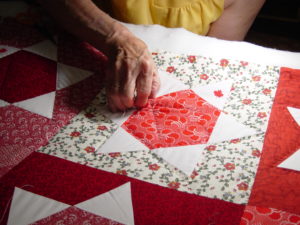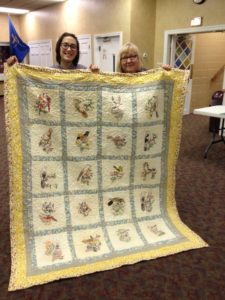Cleo Thoughts, Dust Bowl
Stitches in Time
In most cultures, the older women pass on the skills they have acquired over a lifetime to the next generation like a needle pulling thread in a running stitch. Just as my life as a mother and wife started and my mother’s wealth of knowledge of all things domestic was needed, she passed over Jordan and left me with a bag of washed, ironed and neatly folded chicken feed bags. Vintage ones. Depression/Dust Bowl era muslin. In addition to the organic fabric, the bag held forty-eight ink transfers collected one by one from a newspaper. Each decal depicted the official bird and flower of the pre-Alaska/Hawaii States of America. Raised with the Puritan work ethic of busy hands, my mother hand-stitched even stamp sized fabric into useable comforters. Obviously, she intended on making a quilt by embroidering the squares then sewing them together. I wanted to weep over her lifetime of unfulfilled dreams as my three-year-old son asked, “What’s in the bag, Mommy?”
Getting Started
It took a few months to go to the fabric store and purchase the hoop, needles, embroidery floss and little scissors needed to start the project. At age 33, the recollections of the fine points of stitchery learned while living with my Aunt Lois needed dusting. Aunt Lois lived to hand stitch. In the evenings, Aunt Lois told me what color thread to put in the needles that her nimble fingers pressed along blue inked designs in pillow case and tea towel material. She taught me to make French Knots and keep my stitches tiny and on the blue stenciled line. I learned from a master embroiderer.
Now, the work required me to go it alone. Beset by the pressures of busyness, I decided to double the thread, causing my stitches to rise above the cloth like nubby scars from deep wounds on toughened skin. An interesting outline of the birds and flowers emerged in bias relief. One that any Braille student’s fingers could read accurately. Ten squares resulted from the three years of sewing before I worked on my Master’s Degree and my children oozed into their teen years. Then the bag of fabric and thread was stuffed and forgotten in the back of the closet while a crazy quilt of activities overtook my life.

The Tyranny of Time
Fast forward thirty frantic, fearful and fun years raising a family, teaching special needs children and becoming Glam-ma. No time for embroidering birds or state flowers. My husband and I joined a church down the street from us, and one of the gathering places for women was the Stitchers Club. Crochet, embroidery, tatting, knitting, cross stitch and quilting. Joyce Beenes invited me to come, and so the search for the bag of feed sack cloth began. After cleaning out a few closets, the remnants of a project emerged. The women didn’t laugh, but most had no idea that chicken feed sacks existed, much less served as fodder for sewing. Raised in the city, they traveled to quilt stores all over the Midwest to procure their fabrics. As I sat at the table talking to the Stitchers, they accepted the oddity of my project. Joyce and her friend, Jan Bos, encouraged me to persevere as they finished quilt after quilt.
For four years, every second Friday of the month, I trudged to the fellowship hall and sat among the sewing machines and hand sewers. The rhythmic hum of the machines created a conversational backdrop for the older members of the group. Marge Speelman especially drew me to her side as she told story after story of living in “the old neighborhood” of Englewood/Roseland and raising her children. The difficulty of providing for private Christian school educations for all of them. The faithfulness of God to meet her needs. As her crochet needles clicked slower and the stories were repeated in a predictable loop, Marge stitched her heart to mine and presented me with a love for God deeper than words could express. Her passing left and empty chair and an empty place in my soul. I realized how much the older women from the Greatest Generation taught me about how to live as our needles wove hues of color on blank cloth.
Renewed Spirit
During this time, my husband and I trekked across the Rocky Mountains to visit my brother-in-law in Nevada. At the Colorado Welcome Center, on a huge wall, the finished version of my quilt hung. All fifty states, carefully threaded by volunteers who joined them in a colorful display. Stepping close, I noted the workmanship. No bias relief outline stitches. Every bird and flower was perfectly detailed with filled in hues of finely sewn threads. I knew what I had to do.
Embroidering the squares began in earnest. Taking out the encyclopedia, I copied the colors of the bird’s feathers with my thread, shading in light and dark tones. The flowers, too, burst alive with subtle color changes. The contrast of the outlined figures completed in my youth with the filled in ones recently done, created a kind of schizophrenic combination, as if two completely different individuals had threaded the squares. But that part appeared somewhat true, as my personality over the thirty odd years had changed drastically from an anxious young mother to a settled Glam-ma.
A New Generation of Stitchers
By now, 26 squares lay finished in my basket. A far cry from the 48 possibilities. But help arrived in the form of my 15-year-old granddaughter, Kaeley, who wanted to learn to sew. I figured that the straight stitching of joining posts and sashes would be a foundational start. Little did I know. On the first session, Kaeley took my completed state bird and flower squares and mapped them out on the rug. For an hour, she arranged and rearranged them until a visually balanced rectangle lay on the floor. Snatching her cell phone, she snapped a picture for later reference in laying out the quilt. To the delight of Joyce and Jan, Kaeley became invested in her great-grandmother’s dust bowl project that night.
A year of sewing followed. Some months Kaeley’s teen life did not allow a trip to Stitchers, but most months, she showed up and ran the sewing machine through its paces. A perfectionist, she took out wonky threads. Jan and Joyce guided her through every new process. Every nuance of quilting. Every trick of the trade. Soon the dog feed was changed and Kaeley meandered over fabric, creating flowerlettes as she sewed. I heard a knitter comment, “That girl is fearless.” She was. And she was filled with pride as the last stitch locked into the sash. At age sixteen, Kaeley rose above her peers as the only one who owned a sewing machine and had pieced together a quilt.

Cleo Lampos with her granddaughter and the finished quilt started by Cleo’s mother in the Dust Bowl with feed sack muslin squares and transfers from newspapers.
Kaeley, an art major in college, sleeps under the cottony love of her great-grandmother and her Glam-ma. She finished a dream that started three generations before her. She sleeps under a quilt that Joyce and Jan guided into completion. These two women shared the knowledge of their years of sewing with a novice. A teenager. They did this out of a passion for quilting and for the joy of watching the next generation take up the thread and needle in a creative manner. The older women teaching the younger women to dream in fabrics, designs and colors.
Stitches in time.
 The historical fiction, Dust Between the Stitches, tells the story of Addie Meyers as she tries to save the family homestead from foreclosure while teaching in a one room schoolhouse for script. Each chapter of the book starts with a quilt pattern, many of them based on Sunbonnet Sue and Overall Sam. A picture of life in the Dust Bowl emerges in this novel that will warm your heart and inspire your faith.
The historical fiction, Dust Between the Stitches, tells the story of Addie Meyers as she tries to save the family homestead from foreclosure while teaching in a one room schoolhouse for script. Each chapter of the book starts with a quilt pattern, many of them based on Sunbonnet Sue and Overall Sam. A picture of life in the Dust Bowl emerges in this novel that will warm your heart and inspire your faith.
Quilt meme photo: jjulian812 / Morguefile
Quilt photo: bluekdesign / Morguefile
